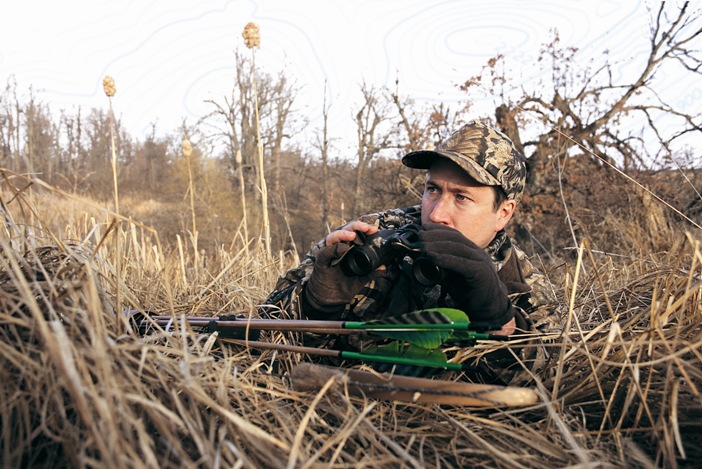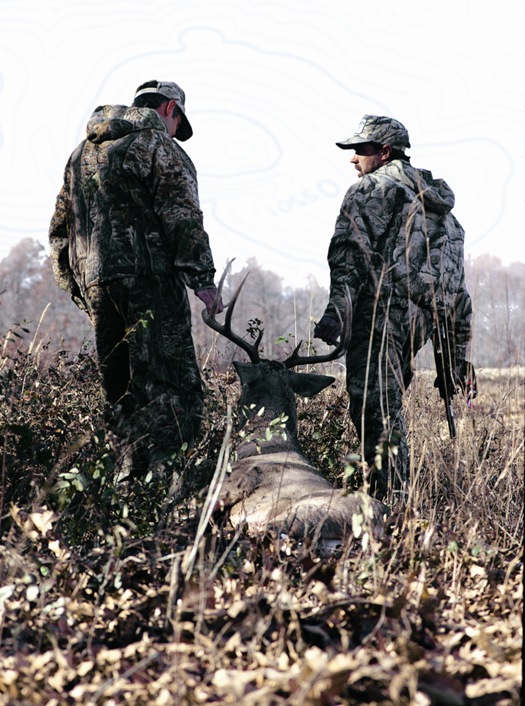Previously: Maps, Maps And More Maps
Step 3: High-Tech Scouting
 You now have some parcels of land that show potential. After using your plat or tax maps to gain permission to hunt, the next step in power scouting is to verify as quickly as possible those strongholds that you suspect harbor deer. There is no use hanging a stand or pussy-footing through unfamiliar turf until you can locate a concentration of deer and deer sign. And there is no reason why you cannot scout several hundred acres in just a few days.
You now have some parcels of land that show potential. After using your plat or tax maps to gain permission to hunt, the next step in power scouting is to verify as quickly as possible those strongholds that you suspect harbor deer. There is no use hanging a stand or pussy-footing through unfamiliar turf until you can locate a concentration of deer and deer sign. And there is no reason why you cannot scout several hundred acres in just a few days.
In farm country, I like to first zero-in on food sources. Wearing rubber boots, I will quickly skirt the edges of active agriculture as well as old orchards, hardwood flats and the edges of steep ravines for deer sign. Do this during the middle of the day when deer are not as likely to be up and about, but pay attention to the wind. You want to avoid having your scent drift into suspected bedding areas.
Then in the evening and early morning hours, I will glass some of these feeding areas as well as likely travel routes from a safe distance so as to not disturb their daily routines. Fence lines, irrigation ditches and hedgerows are favorite corridors used by bucks as they move from bedding cover to preferred feeding locations.
A spotting scope would be handy right about now, but if you are a serious trophy hunter, you might want to invest in a high-power pair of image-stabilizing binoculars that have a better field of view than a spotting scope. By scanning with both eyes you won’t get as tired working the thick cover for a wide rack, either. Best of all, you can hand-hold these optics without the image “jumping” about at long distances.
A few years ago using a topo map on an out-of-state hunt, I located a steep ravine that separated a series of open fields with a hillside of thick brush. I sneaked around that ravine during the middle of the day, and located plenty of big buck sign, including a scrape line that was recently freshened. I still-hunted that scrape line first thing the next morning with my bow, and caught a 140-class 9-pointer flat-footed as he, too, worked the scrape line. At 30 yards, he never knew what hit him!
Wilderness bucks are usually few and far between, so your first order of business is to locate a concentration of deer sign. Using your topo map and aerial photographs, you should be able to pinpoint some logical feeding and bedding areas. I like to concentrate my initial efforts inside clear-cuts and any hardwood ridges that lie above those clear-cuts. Think of the clear-cut as nothing more than a farmer’s hay field, and you should have no problem locating entrance/exit trails and feeding sites within the clear-cut. You should also find deer sign along spurs or gentle slopes that lead to and from those ridges above the clear-cut.
“There is no time to dilly-dally,” adds Miraglia. “Walk as quickly as you can so you will be able to cover as much ground as you can. And so you don’t miss anything, follow a grid pattern until you stumble upon plenty of tracks, rubs and droppings. You might be surprised how small a buck’s core area is in a wilderness setting.”
 Swamps also get my attention, and I will walk directly to any gentle slope or ridge that seems to offer easy access, and look for rubs and scrapes as well as tracks and droppings. I will also look for natural bottlenecks at the top of steep ravines and saddles that lie between hilltops. Bucks will pass through these locations looking for a doe near estrus as the rut nears.
Swamps also get my attention, and I will walk directly to any gentle slope or ridge that seems to offer easy access, and look for rubs and scrapes as well as tracks and droppings. I will also look for natural bottlenecks at the top of steep ravines and saddles that lie between hilltops. Bucks will pass through these locations looking for a doe near estrus as the rut nears.
Don’t overlook that invisible line that separates the open hardwoods from mature softwoods such as hemlock and mixed spruce or fir. Deer love to weave back and forth across this line leaving plenty of scrapes and rubs in the process. When you can add topographical features such as swamps, creek beds or uneven terrain to the mix, you may have a hot spot good for several seasons in a row.
Anyone can power scout. If fact, as Miraglia points out, there is no reason not to make power scouting an integral part of your year-round quest for racked deer. I couldn’t agree more.






